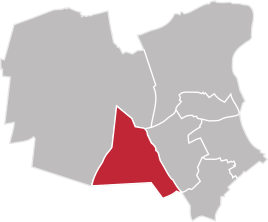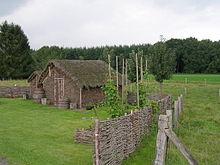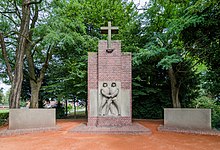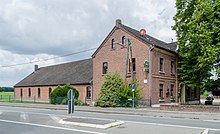Boenninghardt
|
Boenninghardt
Municipality of the Alps
Coordinates: 51 ° 34 ′ 34 ″ N , 6 ° 28 ′ 13 ″ E
|
|
|---|---|
| Height : | 45 m |
| Area : | 5.4 km² |
| Residents : | 1652 (December 31, 2011) |
| Population density : | 306 inhabitants / km² |
| Postal code : | 46519 |
| Area code : | 02802 |
|
Location of Bönninghardt in the Alps
|
|
The Bönninghardt is a section of the Lower Rhine ridge that was formed as a glacial terminal moraine . It rises up to 46 meters above sea level and lies between the Lower Rhine communities of Issum , Sonsbeck and the Alps . The Bönninghardt extends from the Tüschenwald near Sonsbeck to the Leucht national forest in Kamp-Lintfort . The village of the same name Bönninghardt is located in the municipality of Alpen.
history
The Bönninghardt was up to the increased colonization of Höhenzugs beginning of the 20th century, a heath , on the predominantly Besenbinder in sods lived huts. As colonists, mainly from the Palatinate , they came to Bönninghardt, simply called "Hei" in the Lower Franconian dialect , where they soon became impoverished in the dry, less fertile landscape. It was only with improved agricultural techniques that the prerequisites for agricultural use of the ridge were developed, which enabled the settlement and urbanization of the area through high-yielding harvests .
The place, which was already settled in prehistoric times, was mentioned for the first time in 1184 with the permission of the Archbishop of Cologne to the residents of the farms in nearby Borth to cut building and firewood in the archbishopric forest of Berenkart . On a topographic map from 1560, the ridge was finally referred to as Buninckhartse Heyde . In 1643 the Benninckharter Heide served as pasture for "several hundred stuck cattle and works" . In terms of territorial history , the northern part of the Bönninghardt belonged to the Duchy of Kleve , while the southern part, particularly the areas in the Rheinberg district, belonged to Kurköln .
Settlement in the 18th and 19th centuries
From 1770 on, people from the Electoral Palatinate and Pfalzdorf were resettled in the area by the state , who could no longer make a living there. In the course of the inner colonization , Palatine family names such as Barth , Imig , Kalbfleisch , Minor and Scharff came to the Bönninghardter Heide. But also colonists u. a. from the Alps, Dinslaken , Issum, Rheinberg , Sonsbeck, Uedem , Wesel , Winnekendonk and Xanten came to the sterile Bönninghardt. Poverty and neglect were soon the rule; the first new settlers lived in holes in the ground. One found employment mainly as a broom-maker and as day laborer for the farmers. Some of the brooms were transported by the Bönninghardt "on wheelbarrows to Crefeld and even to Düsseldorf".
Division of the Bönninghardt 1808/10
In the years 1808/10, during the time of the French administration, the area of the Colony Bönninghardt covering 3,235.51 ha according to the results of a survey was contractually transferred to the neighboring mayorries of Alpen, Issum, Kamp, Kapellen, Sonsbeck, Veen and Divided into four quarters. Issum accounted for 818.13 ha, Veen 640.50 ha, Alps 549.54 ha, Sonsbeck 421.04 ha, Kapellen or Hamb 412.60 ha, Vierquartier or Saalhoff 338.02 ha and Kamp or Altfeld 55.68 ha. Behind this proportional division was the intention to guarantee a basic supply for the mostly Protestant settlers, which however did not succeed in the result.
Infrastructure measures from 1845
From 1845 Prussia began to build and expand a minimal infrastructure on the Bönninghardt. This is how the government wells were built near the colonists' homesteads, the denominational school buildings in 1852/64 and finally the train station in 1885 on the Haltern-Venlo line of the Cologne-Mindener Eisenbahngesellschaft, which was opened in 1874 . These measures were preceded by the government 's knowledge, which goes back to the Düsseldorf District President Adolph von Spiegel-Borlinghausen , that "to improve the economic situation of the colonists, who are currently sinking into poverty, indebtedness and helplessness, a moderate amount of aid from the fund for agricultural purposes would be justified and appropriate".
The last of many plague huts, a small building filled with turf , was still inhabited until 1896. A surviving picture from 1890 documents the persistent poverty of the dwelling and its inhabitants; Today a reconstruction of it can be seen. With his story Die Vogelfrei der Bönninghardt , first published in 1929 , the Duisburg journalist Hermann Jung set a transfigured literary monument to the young robber Wilhelm Brinkhoff , born in Alpen in 1839, which continues to this day.
Bönninghardt military airfield
On August 8, 1827, the communities of Alpen and Huck (today a district within the community of Alpen) sold a 131- acre and 88- rod piece of pastureland on the Bönninghardt, known as "Alpische Kuhweide", for 1,050 thalers , which was then used by the Prussian 17th Cavalry Landwehr Regiment was used as a drill and equestrian sports field. After the end of the First World War , the area was initially used by the Belgian occupation. The 1936/37 glider airfield was handed over to the National Socialist Fliegerkorps Gruppe Niederrhein on June 1, 1939 . On May 19, 1939, the second group of Jagdgeschwader 26 with 48 aircraft and the task of securing the Dutch and Belgian border had arrived at Bönninghardt airfield. However, it was relocated to the Ruhr area in November without a single mission and replaced by Jagdgruppe 126. Only after the relocation of the first squadron of Jagdgeschwader 20 to Bönninghardt could the first aerial victory be recorded on March 22, 1940, when Lieutenant Harald Jung shot down a Spitfire northwest of Kleve . In the following years airmen stationed on the Bönninghardt took part in the yellow and red cases .
In 1941 it was dedicated to the first order port of operations ; the Bönninghardt military airfield was given the code name Brausebad . The task area of the aviators stationed there shifted more and more to the protection of the German airspace, especially after the lost Battle of Britain, although the airfield lost importance because of the nearby Venlo-Herongen air base . From 1944 at the latest, however, the airfield on the Bönninghardt was also the target of Allied air raids, which in March 1945 led to the final abandonment of the airfield before the approaching Allied troops.
Population development
- 1787: 155
- 1862: 493
- 1910: 557
- 1931: 635
- 2011: 1652 (as of December 31, 2011)
Education and sport
In Bönninghardt there has been a special school since 1983 sponsored by the Wesel district and a football club with the BSV 1951 Rot-Weiß Bönninghardt. In addition, u. a. the Bürgererschützenverein Bönninghardt from 1925 and the Tambourcorps 1949 Bönninghardt active in the village.
Fiction
The Bönninghardt is the central location in Anne Gesthuysen's novel Mädelsabend (2018).
Architectural monuments
literature
- Annals of Agriculture in the Royal Prussian States. Published by the Presidium of the Royal. Landes-Oeconomie-Collegiums. Verlag von Veit und Comp, 4th year, vol. 7, issue 2, Berlin 1846, p. 371 ff. ( Books.google.de ), accessed on November 20, 2011
- Adolf Ernst von Ernsthausen : Statistical representation of the district of Moers. JG Eckner, Moers 1863, p. 102 ( de.wikisource.org ), accessed on November 2, 2013
- The Bönninghardter Haide near the Alps in the Moers district. In: Weekly newspaper of the Johanniter-Ordens-Balley Brandenburg. Volume 8, No. 11 from March 13, 1867 ( books.google.de ), accessed on August 11, 2012
- Richard Pick : On the history of the city and the former Rheinberg office. In: Annals of the historical association for the Lower Rhine, especially the old archdiocese of Cologne . 39 (1883), pp. 1 ff. ( De.wikisource.org ), accessed on December 16, 2011
- Paul von Laer: Inner colonization on the Bönninghardt. In: Otto Constantin, Erwin Stein (eds.): Monographs of German districts. Vol. 3: The district of Moers. Deutscher Kommunal-Verlag, Berlin-Friedenau 1926, pp. 326–335.
- Rudolf Stampfuß : Barrow investigations on the Bönninghardt. In: Prehistoric Journal . 22 (1931), p. 115 ff.
- Karl Reible: The Bönninghardt. In: Local calendar of the district of Moers. 1938, p. 86 ff.
- Blaß: The Bönninghardt 100 years ago. In: War home calendar for Ruhr and Lower Rhine 1943. P. 247 ff.
- Bernhard Roßhoff : The Palatinate settlement on Bönninghardt. In: Heimatkalender Kreis Moers 1964. pp. 83–87.
- Hugo Feltens: Pastor Sanders. Stories about "Little Jan" and old Bönninghardt. In: Heimatkalender Kreis Moers 1967. P. 127–132.
- Hermann Jung: The age of the "bird-free" on the Bönninghardt. In: Hans-Georg Schmitz (Ed.): Alps. Festival book for the 900th anniversary celebration. Büderich 1974, pp. 54-61.
- Hermann Jung: The outlaws of the Bönninghardt. 200 years ago emigrants from the Palatinate had to "make an emergency landing" on the Lower Rhine. In: The home. Journal for Niederrheinische Kultur- und Heimatpflege 48 (1977), pp. 47-48
- Jakob Imig: The Bönninghardt. In: Rhein-Hunsrück-Kalender 35 (1979), pp. 67-70
- Ludger van Bebber, Karl Bröcheler, Johannes Schmitz, Jürgen Wiegert: Bönninghardter Bilderbogen. Geiger-Verlag, Horb / Neckar 1996, ISBN 3-89570-179-3 .
- Karl Bröcheler: Wilhelm Brinkhoff and no end. In: Jahrbuch Kreis Wesel 1998. ISBN 3-87463-259-8 , pp. 67–70.
- Karl Bröcheler: Wilhelm Brinkhoff and no end (part II). In: Jahrbuch Kreis Wesel 1999. ISBN 3-87463-273-3 , pp. 174-181.
- Karl Bröcheler: Water for Bönninghardt. In: Jahrbuch Kreis Wesel 2000. ISBN 3-87463-288-1 , pp. 146–149.
- Ludger van Bebber, Karl Bröcheler, Johannes Schmitz: Bönninghardter Bilderbogen. Schools. Geiger-Verlag, Horb / Neckar 2000, ISBN 3-89570-676-0 .
- Margret Wensky (Ed.): Sonsbeck. The history of the Lower Rhine community from the early days to the present. Böhlau-Verlag, Cologne 2003, p. 51 f.
- Karl Bröcheler: The Plaggenhütte on the Bönninghardt. In: Jahrbuch Kreis Wesel 2004. ISBN 3-87463-354-3 , pp. 163–168.
- Karl Bröcheler: Chestnuts on the Bönninghardt. In: Jahrbuch Kreis Wesel 2005. ISBN 3-87463-373-X , pp. 123–127
- Jürgen Wiegert: The Electoral Cologne Bönninghardt until 1794. ed. from the interest group for history and nature Bönninghardt. 3. Edition. Self-published, o. O. 2010
- Jürgen Wiegert: The Electorate of Cologne Bönninghardt. The life of the first colonists around 1790. In: Jahrbuch Kreis Wesel 2009. ISBN 978-3-87463-434-2 , pp. 19-26.
- Karl Bröcheler: The broom making trade on the Bönninghardt. In: Jahrbuch Kreis Wesel 2009. ISBN 978-3-87463-434-2 , pp. 157-164.
- Jürgen Wiegert: The French on the Bönninghardt. ed. from the interest group for history and nature Bönninghardt. Self-published, o. O. 2010
- Karl Bröcheler: A bestseller from Bönninghardt. Hermann Jung and his "Vogelfrei der Bönninghardt". In: Jahrbuch Kreis Wesel 2011. ISBN 978-3-87463-477-9 , pp. 55–61.
- Karl Bröcheler: A precious good. Water for the Bönninghardter Heide. Self-published, Alps 2011.
- Dieter Schauenberg: The railway on the Bönninghardt. History and stories. In: Jahrbuch Kreis Wesel 2011. ISBN 978-3-87463-477-9 , pp. 90–97.
- Josef Böhmer: The Bönninghardt Forest and its history. In: Jahrbuch Kreis Wesel 2012. ISBN 978-3-87463-493-9 , pp. 112–118.
- Jürgen Wiegert: The fate of the first settlers. Bönninghardt 1770-1780. Neukirchen-Vluyn 2012
- Dieter Schauenberg: The Waschol. History of a small Bönninghardt outskirts. In: Jahrbuch Kreis Wesel 2013. ISBN 978-3-87463-514-1 , pp. 128–132
- Jürgen Wiegert: Drilling rigs on the Bönninghardt. In: Jahrbuch Kreis Wesel 2014. ISBN 978-3-87463-534-9 , pp. 135–140
- Karl Bröcheler: Johann Sanders. The "Little Jan" - an original from the Lower Rhine. In: Jahrbuch Kreis Wesel 2014. ISBN 978-3-87463-534-9 , pp. 171–173
- Tim Michalak / Marc Torke (eds.): HEI-Mat-Chronik Bönninghardt - life at its peak. Anno-Verlag, Ahlen 2017. ISBN 978-3-939256-41-0
- Jürgen Wiegert: The Roman camp on the Bönninghardt. In: Jahrbuch Kreis Wesel 2018. ISBN 978-3-946895-12-1 , pp. 138–143
Web links
- Interest group for history and nature eV Bönninghardt , accessed on December 8, 2011
- Bönninghardt Airport , accessed on November 20, 2011
Individual evidence
- ^ Otto von Mülmann : Statistics of the government district of Düsseldorf , vol. 1, Iserlohn 1864, p. 352.
- ↑ Statistical representation of the district of Moers, Moers 1863, p. 43.
- ↑ Municipal directory 1900, district of Moers
- ↑ The Alpen Office on Gen-Wiki
- ↑ Municipality of Alpen, population statistics according to localities according to the residents' registration office. (PDF; 156 kB) Retrieved April 14, 2013 .








